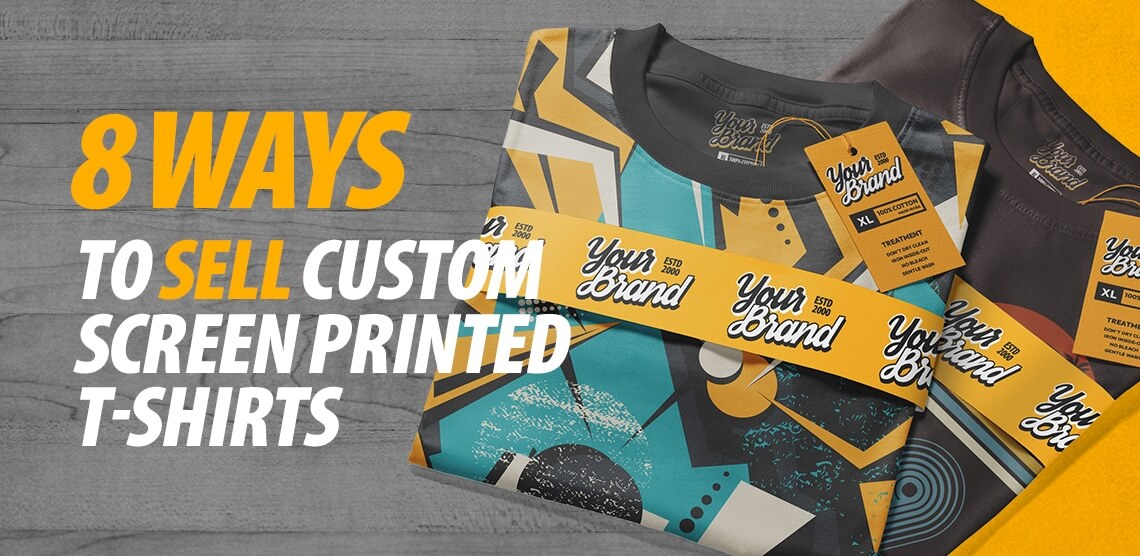Budget-Friendly T-Shirt Printing for Startups
Budget-Friendly T-Shirt Printing for Startups
Blog Article
Screen Printing Uncovered: Everything You Need to Learn About Tee and Garment Printing Techniques
If you've ever questioned exactly how those lively styles wind up on your favorite tees, you remain in the best location. Display printing is an interesting technique that integrates art with method, offering endless possibilities for creativity. Understanding the principles, from tools to ink options, can considerably affect your results. Ready to discover the essential components that make display printing an art form? Allow's uncover the information that can raise your jobs.
The Basics of Display Printing: Exactly How It Works
When you dive right into screen printing, you'll uncover it's both an art and a scientific research. At its core, display printing includes creating a pattern, or screen, that permits ink to go through only in details areas (screen printing kit). You begin by selecting your layout and preparing your screen with a light-sensitive solution. When you expose this solution to light, it hardens, leaving your style as a negative space.
Next, you'll blend your inks and prepare your printing surface. Setting the display over the fabric, after that use a squeegee to press ink through the screen onto the garment. This procedure calls for accuracy, as you want clear, vivid prints. After printing, you'll cure the ink with warmth, ensuring it adheres to the textile and lasts through laundries. Each action is vital, and understanding them will raise your display printing skills, transforming basic garments right into distinct, expressive items.
Kinds Of Display Printing Strategies
As soon as you comprehend the fundamentals of screen printing, it's time to explore the numerous strategies that can raise your styles. One popular method is typical display printing, where ink is pushed with a stenciled screen.
Another choice is plastisol printing, known for its durability and dazzling colors, making it a favored for numerous brand names. Experiment with halftone printing to create slope effects and complex designs.
Necessary Equipment for Display Printing
To achieve stunning results in screen printing, having the right equipment is fundamental. You'll require a sturdy display printing framework, which holds the mesh that transfers your design onto the garment. Next, invest in top quality squeegees; these are important for applying ink evenly throughout the display.
Selecting the Right Inks and Materials
When selecting inks and materials for screen printing, you require to take right into account the sort of ink that functions finest for your job. Consider fabric compatibility to assure your styles look excellent and last long. Also, discover green ink alternatives to make your printing process much more sustainable.
Sorts Of Screen Inks
Picking the ideal screen ink is essential for attaining vibrant, long lasting prints that meet your task's requirements. There are several kinds of screen inks to analyze. Plastisol ink is popular for its adaptability and simplicity of usage, offering excellent shade opacity on dark materials. Water-based ink, on the various other hand, supplies a softer feeling and is environmentally friendly, making it perfect for those aiming to lessen their environmental effect. Release inks eliminate color from the material, causing a soft, vintage appearance but need specific handling. Lastly, specialized inks, such as metallic or glow-in-the-dark, can include distinct results to your designs. Evaluate your job needs and select the ink that straightens best with your preferred end result.

Material Compatibility Considerations
Recognizing fabric compatibility is crucial for accomplishing top notch display prints, particularly because different products respond distinctively to various inks. When choosing inks, consider the textile type-- cotton, polyester, or blends. For cotton, water-based inks work well, offering soft qualities and breathability. Polyester, on the various other hand, typically requires plastisol inks for better attachment and lively colors. You could require to use a mix of both types if you're printing on blends. Constantly check your inks on sample textile to ensure they adhere effectively and preserve color honesty. Furthermore, keep in mind that textile weight and structure can influence the final outcome, so choosing the best ink and product combo is essential for your job's success.
Eco-Friendly Ink Options
Green inks are becoming a prominent selection for display printers who want to decrease their environmental impact while preserving top quality. When picking inks, consider water-based inks, which are less harmful and simpler to cleanse up contrasted to traditional solvents. These inks bond well with fabrics, providing lively outcomes without toxic chemicals. You might likewise check out eco-solvent inks that make use of less volatile organic compounds (VOCs), making them a much safer choice for both your health and wellness and the earth.
Additionally, look for inks made from renewable energies, such as soy or vegetable-based alternatives. By picking the ideal inks and products, you'll not only produce spectacular designs yet likewise add to an extra lasting printing process. Make the button, and your prints will mirror your commitment to the setting!
Preparing Your Design for Display Printing

Submit Layout Demands
To assure your design looks sharp and vibrant on textile, you'll need to pay close interest to file style requirements for display printing. Make certain your design has a transparent background to avoid unwanted white sides on your prints. Maintain shade settings in mind; CMYK is conventional for display printing, so convert your RGB makes as necessary.
Shade Splitting Up Strategies
Shade splitting up is an essential action in preparing your layout for screen printing, and grasping it can greatly boost your print quality. You'll require to damage your design right into individual colors, as each color requires a separate display throughout printing. Beginning by identifying all the colors in your layout and develop layers for each one. You can use software like Adobe Photoshop or Illustrator to separate and separate shades effectively. Be specific to conserve each layer as a different data, commonly in a style like TIFF or PSD. This precision not only guarantees accurate shade depiction however also simplifies the printing procedure. By taking note of shade splitting up, you'll attain expert and vibrant lead to your screen-printed garments.
Resolution and Dimension
Accomplishing the most effective cause display printing begins with assuring your style has the best resolution and dimension. Ideally, your art work should be at least 300 DPI (dots per inch) for sharp, clear prints. If you utilize reduced resolution, your last product might look pixelated and less than professional.
When it involves dimension, consider the dimensions of your print area. Style your artwork to match the final print size, ideally producing it in the actual measurements you'll be printing. By doing this, you'll prevent any kind of unforeseen scaling concerns.
Always examine your layout in both vector and raster formats. Vector graphics can why not try here be scaled without losing top quality, making them suitable for display printing. Preparing appropriately will ensure your layout looks impressive on every garment!
Step-by-Step Display Printing Refine
Display printing is a vibrant process that enables you to develop dynamic designs on different surface areas. To get started, you'll need a screen, emulsion, and your chosen ink.
Pour ink onto the display and make use of a squeegee to push the ink via the pattern onto the fabric. Lift the display meticulously and let the print completely dry. see You have actually successfully display printed your style.
Tips for Effective Display Printing Projects
While you're diving right into your screen printing tasks, keep in mind that prep work is vital to success. Begin by gathering all your materials-- inks, mops, screens, and garments. A tidy work space helps protect against undesirable errors, so tidy up before you start.
Following, verify your art work is high-resolution and appropriately sized for your garment. Examine your screen for proper direct exposure and clean it thoroughly to avoid spots. When mixing your inks, comply with the maker's guidelines to attain the appropriate uniformity.
Throughout printing, use also stress with your squeegee for regular results. Don't hurry; take your time to validate each print satisfies your criteria. After printing, let your garments dry completely prior to managing or packaging them.
Finally, constantly keep an example of your job for future referral. In this manner, you can examine your progress and enhance your techniques with time. Satisfied printing!

Frequently Asked Inquiries
How much time Does It Take to Establish a Display Printing Work?
Setting up a screen printing task generally takes about 30 minutes to an hour. You'll prepare the displays, mix inks, and adjust journalism. The moment differs based on complexity and experience, so remain organized!
Can I Print on Various Material Enters Using the Same Strategy?
Yes, you can publish on different fabric kinds utilizing the same strategy, however you'll need to readjust your setups and inks. Some fabrics soak up ink in different ways, so exploring guarantees the very best outcomes for each product.
What Are Common Blunders to Prevent in Screen Printing?
When display printing, avoid usual errors like using the incorrect ink, overlooking proper direct exposure times, or skipping pre-press checks. Constantly evaluate your arrangement and preserve tidy screens to assure high quality outcomes each time.
Exactly How Can I Properly Clean and Maintain My Screen Printing Equipment?
To appropriately tidy and preserve your screen printing devices, you should routinely clean screens with read review ideal solvents, check mops for wear, and assure all devices are stored completely dry and dust-free. Uniformity improves and protects against costly repair services efficiency.
Is Screen Printing Eco-friendly Compared to Other Techniques?
Display printing can be more ecologically pleasant than various other methods, particularly if you make use of water-based inks and eco-conscious materials. By selecting lasting supplies and methods, you minimize waste and decrease your influence on the planet.
Screen Printing Uncovered: Whatever You Required to Know Concerning Tee and Garment Printing Techniques
At its core, screen printing includes producing a pattern, or display, that permits ink to pass via just in specific areas. Setting the screen over the material, after that make use of a squeegee to press ink via the display onto the garment. One preferred method is conventional screen printing, where ink is pushed with a stenciled screen.When selecting inks and materials for screen printing, you need to take into account the type of ink that works best for your project.
Report this page